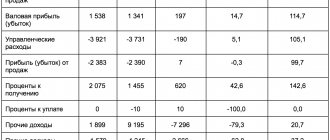Cases of accounts receivable
Accounts receivable may arise, for example, in the following cases:
| Who has the receivables? | Base |
| Buyer | The supplier did not ship the goods paid in advance to the buyer |
| Customer | The contractor did not perform (provide) the work (services) paid in advance to the customer. |
| Provider | The buyer did not pay the supplier for the goods supplied by him |
| Executor | The customer did not pay the contractor for the work performed (services provided) |
| Lender | The borrower did not repay the loan received to the lender |
| Employing organization | The employee did not report on the amounts received under the report |
Statute of limitations
The general limitation period is three years. It will be easier to correctly count these three years using the table.
| Situation | From what date does the statute of limitations begin? |
| The deadline for fulfilling the obligation is determined | Upon expiration of the obligation |
| The deadline for fulfilling the obligation is not determined | From the day the creditor made a demand to fulfill obligations (for example, sent a letter) |
| The execution period is determined by the moment of demand | |
| The creditor gave the debtor some time to fulfill the obligation | At the end of the last day of the obligation fulfillment period |
This follows from the provisions of Article 196 and paragraph 2 of Article 200 of the Civil Code of the Russian Federation.
An example of determining the limitation period. The limitation period was not interrupted
Trading LLC shipped goods to Alpha LLC on January 13, 2021. According to the contract, payment must be made no later than 10 calendar days after shipment, that is, no later than January 23, 2016. However, payment was not received from Alpha on time.
The limitation period must be calculated from January 24, 2021 to January 24, 2021 inclusive (provided that the limitation period was not interrupted).
The limitation period may be interrupted when the debtor commits actions that indicate recognition of the debt.
After the break, the limitation period begins again. At the same time, do not count the time that elapsed before the break into the new limitation period. However, there is a limitation: the limitation period cannot exceed 10 years from the date of violation of the right, even if the period was interrupted. The exception is the cases established by the Law of March 6, 2006 No. 35-FZ on countering terrorism.
This is stated in paragraph 2 of Article 196, Article 203 of the Civil Code of the Russian Federation.
The debtor can recognize his debt even after the statute of limitations has expired. In this case, from the moment the debt is recognized, the limitation period begins anew. Such rules are established in paragraph 2 of Article 206 of the Civil Code of the Russian Federation.
An example of determining the limitation period. The limitation period was interrupted
On January 13, Trading LLC shipped goods to Alpha LLC. According to the contract, payment must be made no later than 10 calendar days after shipment, that is, no later than January 23. However, payment was not received from Alpha on time.
The limitation period begins to count from January 24.
On January 25, Hermes sent a letter of claim to Alpha. On February 1, the parties drew up a reconciliation report. This means that Alpha has admitted its debt. In this case, the limitation period begins to count again - from February 2.
Situation: what actions of the debtor indicate recognition of the debt and are grounds for considering the statute of limitations interrupted?
The legislation does not establish a list of actions by the debtor that indicate that he has acknowledged the debt. And which may serve as a basis for interrupting the limitation period (Article 203 of the Civil Code of the Russian Federation).
However, an approximate list of such actions is named in paragraph 20 of the resolution of the Plenum of the Supreme Court of the Russian Federation dated September 29, 2015 No. 43. In particular, it includes:
- recognition of the claim. However, the response to the claim does not in itself indicate recognition of the debt. It must indicate that the debtor has acknowledged the debt;
- a change in the contract, from which it follows that the debtor acknowledged the existence of a debt. Or the debtor’s request to change such an agreement (for example, on a deferment or installment plan);
- signing the debt reconciliation act.
For example, three years have passed since the date when the obligations were due. But during this period, the parties signed a debt reconciliation act. This act is the basis for interrupting the statute of limitations (letter of the Ministry of Finance of Russia dated July 19, 2011 No. 03-03-06/1/426). Therefore, the three-year period must be counted from the day on which the last reconciliation act dates. There are exceptions to this rule - these are events due to which the receivables have become unrealistic for collection. A similar position is set out in the letter of the Federal Tax Service of Russia dated December 6, 2010 No. ШС-37-3/16955.
The contract may provide that the obligation can be fulfilled in parts (in the form of periodic payments). In this case, if the debtor has performed actions indicating recognition of only some part of the obligation, they do not constitute grounds for interrupting the limitation period for other parts of the obligation. This is stated in paragraph 20 of the resolution of the Plenum of the Supreme Court of the Russian Federation dated September 29, 2015 No. 43.
Methods for creating a reserve and algorithm of actions
There are three options when, if there are objective doubts that you will receive all or part of the amounts due, they can be defined as sources of backup income:
- interval - when it is calculated that the repayment of monetary obligations can be in parts in each billing period, for example, monthly or quarterly;
- expert – assess the real amount of losses associated with non-payment of contracts;
- statistical - based on data from previous years, the percentage probability of non-payment of debts is calculated in proportion to the total receivables.
The calculation method is selected in accordance with the criteria for determining insolvency approved by internal regulations.
The basic rules that guide the formation of a reserve include:
- it is needed, regardless of the size of the debt;
- the reason is the debt remaining at the end of the contractual terms;
- it does not matter if the debtor has partially paid, but there remains an overdue amount.
First of all, the manager himself should be interested, since he will be able to objectively assess the size of receivables.
It is quite logical that you can control who is still owed, despite the deadlines for payment, through an appropriate inventory.
With the exception of the requirements and reasons for conducting an inventory established by law, internal regulations determine:
- situations when it is necessary to carry out an audit as part of the inventory;
- timing and order of control measures;
- objects being checked.
Having found out whether there is a debt that you doubt to collect, document the creation of an account where you will reflect the amounts that are unlikely, but can be transferred.
There are no legal restrictions on minimum or maximum sizes.
An allowance for doubtful debts is recorded as other expenses.
Documenting
The fact of the occurrence of receivables must be documented (Part 1, Article 9 of the Law of December 6, 2011 No. 402-FZ).
Determine the amount of overdue accounts receivable based on the results of the inventory and reflect it in the act, for example, according to form No. INV-17. Carry out the inventory by order of the manager (form No. INV-22).
To write off accounts receivable, the manager must issue an appropriate order. The basis for this will be an inventory act and an accounting certificate.
This is stated in paragraph 77 of the Regulations on Accounting and Reporting, letter of the Federal Tax Service of Russia for Moscow dated December 13, 2006 No. 20-12/109630.
Attach documents confirming its occurrence to the accounts receivable inventory report, for example:
- agreements that specify the terms for repayment of obligations by counterparties;
- invoices;
- certificates of work performed (services rendered);
- acts of inventory of receivables at the end of the reporting (tax) period.
This procedure follows from letters of the Ministry of Finance of Russia dated April 8, 2013 No. 03-03-06/1/11347 and the Federal Tax Service of Russia for Moscow dated April 13, 2011 No. 16-15/035618.1.
Accounting
Write off the amount of debt against the reserve for doubtful debts.
In accounting, reflect the write-off of accounts receivable from the reserve for doubtful debts by posting:
Debit 63 Credit 62 (58-3, 71, 73, 76...) – accounts receivable are written off from the created reserve.
The reserve can be used only within the reserved amounts. If during the year the amount of expenses for debt write-off exceeds the amount of the created reserve, reflect the difference as part of other expenses (clause 11 of PBU 10/99).
When writing off the difference, make the following entry:
Debit 91-2 Credit 62 (58-3, 71, 73, 76...) – accounts receivable not covered by the reserve are written off.
Writing off receivables for which the statute of limitations has expired, or other debts that are unrealistic to collect, does not constitute cancellation of the debt. Therefore, within five years from the date of write-off, reflect it on the balance sheet in account 007 “Debt of insolvent debtors written off at a loss” (Instructions for the chart of accounts):
Debit 007 – written off receivables are reflected.
During this period, monitor the possibility of its collection if the debtor’s property status changes (clause 77 of the Regulations on Accounting and Reporting).
If the debt written off from the balance sheet can be collected or the debtor pays it off voluntarily, make the following entries in your accounting:
Debit 51 Credit 76 – money was received to repay previously written off receivables;
Debit 76 Credit 91-1 – other income is reflected in the amount of repaid previously written off receivables;
Loan 007 – written-off receivables have been repaid.
An example of how written off receivables are reflected in accounting
Alpha LLC conducts a quarterly inventory of accounts receivable and makes deductions to the reserve for doubtful debts in accounting.
The unused balance of the reserve for doubtful debts for the second quarter amounted to RUB 45,400.
According to the results of the inventory as of September 30, the organization’s records included:
1) doubtful accounts receivable of organizations:
LLC "Torgovaya" - 170,700 rubles;
2) debt of LLC “Proizvodstvennaya” in the amount of 45,400 rubles. In the third quarter, Master's debt was recognized as unrealistic for collection due to the liquidation of the debtor organization (confirmed by an extract from the Unified State Register of Legal Entities). The amount of debt was fully taken into account when creating the reserve.
Based on the inventory results as of September 30, Alpha’s accountant included Hermes’ debt in the amount of RUB 170,700 in the reserve for doubtful debts.
The Master's debt was completely written off from the reserve.
In Alpha's accounting, a reserve was created in the amount of 170,700 rubles.
Taking into account the balance of the reserve as of June 30 and the written off debt of Master, the additional amount of expenses for the formation of the reserve in the third quarter amounted to: 45,400 rubles. + 170,700 rub. – 45,400 rub. = 170,700 rub.
On September 30, Alpha’s accountant made the following entries:
Debit 63 Credit 62 – 45,400 rub. – accounts receivable are written off from the reserve;
Debit 91-2 Credit 63 – 170,700 rub.
– reflects the costs of creating a reserve for doubtful debts.
Transfer of debt
According to Art. 266 of the Tax Code of the Russian Federation, the amount of doubtful debt not completely written off in the current period can be transferred to the next. The newly created reserve must be adjusted to the amount of the balance: if it is less, then the difference relates to non-operating income; if more - to expenses.
At the end of the year, adjustments occur as follows. If a decision is made to form a reserve for the next year, the amount is transferred. If not, then the balance should be included in non-operating income.






